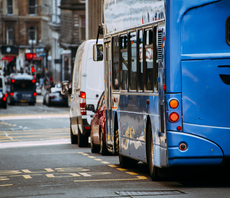‘Justified to save lives’: Are clean air zones moving into the fast lane?


Mayor of London wants capital’s ultra-low emissions zone to be extended to cover all London by 2023, as Greater Manchester mayor submits fresh vision to tackle pollution in North West
The battle to deliver cleaner urban air in the UK is heating up, with London Mayor Sadiq Khan endorsing a plan to significantly expand the area covered by the capital’s pollution charge scheme, while his counterpart in Manchester, Andy Burnham, unveiled plans to significantly revise controversial proposals for a clean air zone in the city.
This morning, Khan confirmed he wants the London’s Ultra-Low Emission Zone (ULEZ) to be extended to the outermost part of the city’s boroughs, following the successful introduction in 2019 of a charge on drivers of the most polluting vehicles who enter an extensive zone covering central London.
Following evidence the scheme had delivered significant improvements to air quality, the ULEZ was extended last October to the area between the capital’s north and south circular orbital roads. And today Khan announced he wants to expand the zone even further, confirming he has asked Transport for London to consult on expanding the ULEZ to cover all of London by 2023.
Unveiling the proposal, Khan said he had carefully considered the rising cost of living but stressed the move was “justified to save lives and protect the health of Londoners”.
“The triple challenges of tackling toxic air pollution, the climate emergency and congestion mean we must significantly reduce emissions from vehicles in London,” he wrote on Twitter.
City Hall estimates that an extended ULEZ would reduce the number of the most polluting cars on London’s roads by between an additional 20,000 and 40,000 a day, preventing more than 550,000 Londoners from developing diseases attributable to air pollution over the next 30 years. It said toxic air caused by traffic was hurting lung growth in children and was causing almost 4,000 premature deaths a year, mainly in London’s outer boroughs.
Khan promised that any expansion of the scheme would be accompanied with a scrappage scheme that would help Londoners on low incomes, disabled Londoners, and businesses upgrade to cleaner vehicles.
It remains to be seen how popular the move will be, but Khan’s plan to launch the scheme the year before the next mayoral elections suggests confidence the move can secure a positive public reception.
Congestion charging schemes are becoming increasingly common around the UK as councils have sought to reduce air pollution caused by traffic and curb the number of deaths and hospital visits attributed to dirty urban air. Bath, Birmingham, and Portsmouth have Clean Air Zones in place to tackle pollution and congestion, with further schemes expected to come online this year in Bradford and Bristol. To date, London and Birmingham are the only cities where private drivers are charged, alongside commercial vehicles, but experts think charging schemes could become more widespread.
However, Covid-19 has slowed the introduction of such schemes across the UK, as local authorities prioritised avoiding further disruption to local businesses in the wake of the pandemic. Birmingham’s scheme was launched 11 months later than planned last year and Clean Air Zones in Liverpool and Sheffield have been similarly postponed due to the pandemic. A scheme in Leeds was scrapped altogether.
Meanwhile, in Greater Manchester plans for a Clean Air Zone continue to evolve, after the roll out of an initial zone was put on hold last month amid significant concern the charge could put local taxi drivers and small business owners out of business.
A revised plan is expected in July, and this week Greater Manchester mayor Andy Burnham wrote to the Prime Minister to call for the plans for a charging scheme to be replaced with a system based on incentives.
In his letter to the Prime Minister, Burnham suggested that no vehicles should be charged by the new Clean Air Zone, with cameras installed across the zone used instead to signpost non-compliant vehicles to financial support.
The plan for a non-charging zone has been backed by the nine Labour leaders of Greater Manchester, who maintain Manchester will be able to achieve legal air pollution limits without a charging scheme, Burnham said.
Burnham stressed the revised plans depended on more funding being provided to help people upgrade their vehicles. “Any new scheme should be based on incentives for individuals and businesses to change vehicles rather than a charging penalty regime,” he said. “But, to succeed, this will require your government to agree to the extra financial investment needed to enable vehicle upgrades to happen without the owners incurring unacceptable costs.”
Manchester was originally directed by the government to meet legal air pollution limits by 2024, but that deadline has now been extended by two years after the government issued a fresh ministerial directive to city councils last month.
Burnham’s letter setting out the new vision for the zone came just a few days after the Northern leader accused the Prime Minister of “playing dishonest politics” on the issue, noting that Boris Johnson had been quick to brand Manchester’s clean air charging scheme as “badly thought out” and “wrong” during a recent appearance at Prime Minsters Questions, despite it being his government that had mandated action on air pollution in the city in the first place.
“We will not put up with this any longer,” Burnham said in a statement. “We can’t have Ministers saying things to us in private which are then flatly contradicted by the Prime Minister at the Despatch Box. Are the government requiring Greater Manchester to have a Clean Air Zone or not? They must give a straight answer to that question and they must do it today.”
However, if the politics of introducing the kind of charging-based Clean Air Zones that are shown to be most effective at driving down air pollution and encouraging people to switch to electric vehicles and other cleaner models remains challenging, the case for action to tackle air pollution continues to get more compelling. Fresh research was published this week, which was commissioned by the Clean Air Fund and claimed the UK would be able to reach World Health Organisation (WHO)’s target for air quality by 2030 if existing clean air, transport, and environmental policies are implemented in full.
The study from Imperial College London researchers also calculates that reducing air pollution to this WHO-aligned level by 2030 would deliver significant health and economic benefits to the tune of £380bn, increasing life expectancy and significantly reducing incidences of asthma and heart disease.
“This is a win, win, win scenario” said Jane Burston, executive director at the Clean Air Fund. “This new research shows us that achieving much healthier air is possible across the vast majority of the UK by 2030 based on policies the government already plans to implement or that have been recommended by the Committee on Climate Change.”
The UK is set to update its target later this year, but its current target for fine particulate matter, known as PM2.5, is currently 20 micrograms per cubic metre – four times more the level recommended as safe by the WHO.
In 2021, the UN agency reduced its guideline level from 10 micrograms to 5 micrograms, in light of new scientific evidence on the dangers of even low levels of air pollution. The 10-microgram limit, known as WHO-10, has now been designated an ‘interim target’ that countries should meet on the way to delivering more ambitious improvements.
Burston said the new air quality target in the UK should align with WHO-10 at a minimum, with a view to further reducing pollution beyond this in the future. “It is necessary, beneficial and achievable, and will save lives and money,” she said.
The coroner into the inquest into the death of Ella Kissi-Debrah, the first person in the UK to have air pollution recognised as a cause of death on their death certificate, recommended the government adopt WHO guidelines as a legal target. Campaigners have pointed out that adopting the WHO-10 target would make the UK the second European country to do so, setting an example on the global stage.
The research published this week argues such a target would be achievable “almost everywhere” in the UK by 2030, with less than one per cent of the country predicted to experience pollution above the WHO target if existing environment, air, transport, and climate policies – including plans to end the sale of new internal combustion engine cars and vans by the end of the decade – are met.
In response to the call to action, a spokesperson for the Department for Food, Environment, and Rural Affairs said emissions of PM2.5 had come down 18 per cent since 2010. “To continue to drive forward tangible and long-lasting improvements to air quality we are committed to setting stretching and ambitious targets on air quality through our Environment Act,” they said.
The government intends to establish two new targets for fine particulate matter, one focused on reducing the annual mean concentration level of PM2.5 in ambient air and the other to reduce population exposure to PM2.5 in the long-term. But it has argued that making the UK’s major cities compliant with the updated WHO guideline levels would have a disproportionate impact on society and small local businesses, stating that the guidelines are there to inform the setting of air quality standards, but are not ready-made targets for adoption.
It remains to be seen whether London and Manchester’s respective plans for tackling pollution and congestion from vehicles in their cities will be adopted in full, but it is clear that Clean Air Zones are a concept here to stay, with first mover cities already reaping the benefits of cleaner air and less congested roads. The introduction of new air pollution targets on a national level could see yet more cities forced to take action and further ramp up pressure on businesses and authorities right across the UK to switch to zero emission fleets and accelerate improvements to public transport and active travel networks.
Want to find out more about how the net zero transition will impact your business? You can now sign up to attend the virtual Net Zero Finance Summit, which will take place live and interactive on Tuesday 29 March and will be available on demand for delegates after the event.














